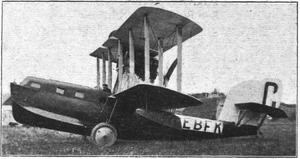Top speed 150 km/h Length 11 m First flight June 1923 Designer R. J. Mitchell | Wingspan 14 m Retired 1928 | |
 | ||
The Supermarine Sea Eagle was a British, passenger–carrying, amphibious flying boat. It was designed and built by the Supermarine Aviation Works for its subsidiary, the British Marine Air Navigation Co Ltd, to be used on their cross-channel route between Southampton, the Channel Islands and France.
Contents
Service
Three aircraft were constructed, G-EBFK, G-EBGR and G-EBGS and the regular service between Southampton and Guernsey began on 25 September 1923 (the planned service to France was never implemented). This was the world's first scheduled passenger air service by flying boat. However, G-EBFK crashed on 21 May 1924; in January 1927, G-EBGS was lost when it was rammed by a ship in the harbor of St Peter Port, Guernsey. The third aircraft continued on the route until 1928 when it was replaced by a Short S.8 Calcutta.
The wooden hull of the surviving Sea Eagle, G-EBGR, was retained by Vickers until 1949, when they presented it to the British Overseas Airways Corporation; BOAC burnt it in 1954 because of a lack of storage space.
Variants
The Supermarine Sheldrake used the hull of the Sea Eagle and the wings of the Seagull with a tractor engine installation. A single example was built. The Supermarine Scarab was a military flying-boat, based on the Sea Eagle and Sheldrake but with a pusher engine. Twelve were built for the Spanish Naval Air Service for use in the bomber/reconnaissance role. It was fitted with a .303 in (7.7 mm) Lewis gun and a bomb load of 1,000 lb 454 kg.
Operators
Specifications
Data from Supermarine Aircraft since 1914
General characteristics
Performance
